An Improved Microseismic Signal Denoising Method of Rock Failure for Deeply Buried Energy Exploration
Abstract
:1. Introduction
2. Materials and Methods
2.1. Engineering Background and Data Source
2.1.1. Engineering Background
2.1.2. Dataset Sources
2.2. The Proposed Method and Principle
2.2.1. Principle of Wavelet Threshold Denoising
- (1)
- Decomposition: Select the wavelet and determine the number of layers of wavelet decomposition.
- (2)
- Threshold processing: Select the threshold value and threshold function for nonlinear processing of wavelet coefficients.
- (3)
- Reconstruction: Use the new wavelet coefficients to reconstruct the signal and obtain the filtered signal.
2.2.2. Selection of Wavelet Threshold and Function
2.2.3. Improved Denoising Method
2.2.4. Parameter Selection
3. Results
3.1. Data and Evaluation Indicators
3.2. Denoising Effect for Different Types of Synthetic Signals
3.3. Denoising Effect of Different SNR Synthetic Signals
4. Discussion
5. Conclusions
- (1)
- Through a threshold selection test, the improved threshold criterion was used to vary the wavelet threshold with changes in the decomposition scale, and the microseismic and noise signal components were effectively distinguished. The new threshold function overcame the step phenomenon and value deviation issues of the traditional threshold function. The number of decomposition levels was determined based on an evaluation index to reduce signal distortion.
- (2)
- Compared with the wavelet global threshold, EMD and EMD-WT methods, the improved wavelet threshold denoising method displayed better denoising performance for different types of synthetic signals with different SNRs. It overcomes or effectively makes up for the shortcomings of other methods, such as losing some useful information, retaining noise-related information and yielding invalid denoising results.
- (3)
- The denoising evaluation of real microseismic signals further shows that the proposed method can remove different types of noise, significantly improve the SNR of microseismic data, and restore the microseismic information to the greatest extent. The method proposed in this paper greatly promotes the optimization of microseismic denoising for complex, deeply buried, energy exploration.
Author Contributions
Funding
Data Availability Statement
Conflicts of Interest
References
- Wang, Q.H.; Zhang, Y.T.; Xie, Z.; Zhao, Y.W.; Zhang, C.; Sun, C.; Wu, G.H. The Advancement and Challenges of Seismic Techniques for Ultra-Deep Carbonate Reservoir Exploitation in the Tarim Basin of Northwestern China. Energies 2022, 15, 7653. [Google Scholar] [CrossRef]
- Moscariello, A. Exploring for geo-energy resources in the Geneva Basin (Western Switzerland): Opportunities and challenges. Swiss Bull. Angew. Geol. 2019, 24, S105–S124. [Google Scholar]
- Wang, J.X.; Tang, S.B. Novel Transfer Learning Framework for Microseismic Event Recognition between Multiple Monitoring Projects. Rock Mech. Rock Eng. 2022, 55, 3563–3582. [Google Scholar] [CrossRef]
- Tang, S.B.; Li, J.M.; Ding, S.; Zhang, L.T. The influence of water-stress loading sequences on the creep behavior of granite. Bull. Eng. Geol. Environ. 2022, 81, 482. [Google Scholar] [CrossRef]
- Wójcik, K.; Zacharski, J.; Łojek, M.; Wróblewska, S.; Kiersnowski, H.; Waśkiewicz, K.; Wójcicki, A.; Laskowicz, R.; Sobień, K.; Peryt, T.; et al. New Opportunities for Oil and Gas Exploration in Poland—A Review. Energies 2022, 15, 1739. [Google Scholar] [CrossRef]
- Liang, X.; Tang, S.B.; Tang, C.A.; Hu, L.H.; Chen, F. Influence of water on the mechanical properties and failure behaviors of sandstone under triaxial compression. Rock Mech. Rock Eng. 2023, 56, 1131–1162. [Google Scholar] [CrossRef]
- Li, J.M.; Li, K.Y.; Tang, S.B. Automatic arrival-time picking of P-and S-waves of microseismic events based on object detection and CNN. Soil Dyn. Earthq. Eng. 2023, 64, 107560. [Google Scholar] [CrossRef]
- Keneti, A.; Sainsbury, B.A. Review of published rockburst events and their contributing factors. Eng. Geol. 2018, 246, 361–373. [Google Scholar] [CrossRef]
- Li, J.M.; Tang, S.B.; Song, H.B.; Chen, X.J. Engineering properties and microstructure of expansive soil treated with nanographite powder. J. Central South Univ. 2022, 29, 499–514. [Google Scholar] [CrossRef]
- Jiang, Y.D.; Zhao, Y.X.; Wang, H.W.; Zhu, J. A review of mechanism and prevention technologies of coal bumps in China. J. Rock Mech. Geotech. Eng. 2017, 9, 180–194. [Google Scholar] [CrossRef]
- Chen, B.R.; Feng, X.T.; Li, Q.P.; Luo, R.Z.; Li, S.J. Rock burst intensity classification based on the radiated energy with damage intensity at Jinping II hydropower station, China. Rock Mech. Rock Eng. 2015, 48, 289–303. [Google Scholar] [CrossRef]
- Tang, S.B.; Wang, J.X.; Chen, P.Z. Theoretical and numerical studies of cryogenic fracturing induced by thermal shock for reservoir stimulation. Int. J. Rock Mech. Min. Sci. 2020, 125, 104160. [Google Scholar] [CrossRef]
- Ma, T.H.; Tang, C.A.; Tang, S.B.; Kuang, L.; Yu, Q.; Kong, D.Q.; Zhu, X. Rockburst mechanism and prediction based on microseismic monitoring. Int. J. Rock Mech. Min. Sci. 2018, 110, 177–188. [Google Scholar] [CrossRef]
- Tang, S.B.; Wang, J.X.; Tang, C.A. Identification of microseismic events in rock engineering by a convolutional neural network combined with an attention mechanism. Rock Mech. Rock Eng. 2021, 54, 47–69. [Google Scholar] [CrossRef]
- Zhang, C.; Jin, G.; Liu, C.; Li, S.; Xue, J.; Cheng, R.; Wnag, X.; Zheng, X. Prediction of rockbursts in a typical island working face of a coal mine through microseismic monitoring technology. Tunn. Undergr. Space Technol. 2021, 113, 103972. [Google Scholar] [CrossRef]
- Zhang, W.; Feng, X.T.; Bi, X.; Yao, Z.B.; Xiao, Y.X.; Hu, L.; Niu, W.J.; Feng, G.L. An arrival time picker for microseismic rock fracturing waveforms and its quality control for automatic localization in tunnels. Comput. Geotech. 2021, 135, 104175. [Google Scholar] [CrossRef]
- Li, H.L.; Tuo, X.G.; Wang, R.L.; Courtois, J. A reliable strategy for improving automatic first arrival picking of high noise three component microseismic data. Seismol. Res. Lett. 2019, 90, 1336–1345. [Google Scholar] [CrossRef]
- Zhou, Y.; Wu, G. Unsupervised machine learning for waveform extraction in microseismic denoising. J. Appl. Geophys. 2020, 173, 103879. [Google Scholar] [CrossRef]
- Anvari, R.; Siahsar, M.A.N.; Gholtashi, S.; Kahoo, A.R.; Mohammadi, M. Seismic random noise attenuation using synchrosqueezed wavelet transform and low-rank signal matrix approximation. IEEE Trans. Geosci. Remote Sens. 2017, 55, 6574–6581. [Google Scholar] [CrossRef]
- Lu, C.P.; Dou, L.M.; Zhang, N.; Xue, J.H.; Wang, X.N.; Liu, H.; Zhang, J.W. Microseismic frequency-spectrum evolutionary rule of rockburst triggered by roof fall. Int. J. Rock Mech. Min. Sci. 2013, 64, 6–16. [Google Scholar] [CrossRef]
- Lu, C.-P.; Dou, L.-M.; Liu, B.; Xie, Y.-S.; Liu, H.-S. Microseismic low-frequency precursor effect of bursting failure of coal and rock. J. Appl. Geophys. 2012, 79, 55–63. [Google Scholar] [CrossRef]
- Griffin, D.; Lim, J. Signal estimation from modified short-time Fourier transform. IEEE Trans. Acoust. Speech Signal Process. 1984, 32, 236–243. [Google Scholar] [CrossRef]
- Reddy, B.S.; Chatterji, B.N. An FFT-based technique for translation, rotation, and scale-invariant image registration. IEEE Trans. Image Process. 1996, 5, 1266–1271. [Google Scholar] [CrossRef] [Green Version]
- Mirković, D.; Mahasoom, R.; Johnsson, L. An adaptive software library for fast fourier transforms. In Proceedings of the 14th International conference on Supercomputing, New York, NY, USA, 8–11 May 2000; pp. 215–224. [Google Scholar]
- Feichtinger, H.G.; Strohmer, T. Gabor Analysis and Algorithms: Theory and Applications; Springer Science & Business Media: Berlin/Heidelberg, Germany, 2012. [Google Scholar]
- Morlet, J.; Arens, G.; Fourgeau, E.; Giard, D. Wave propagation and sampling theory, Part I: Complex signal land scattering in multilayer media. Geophysics 1982, 47, 203–221. [Google Scholar] [CrossRef] [Green Version]
- Chun-Lin, L. A tutorial of the wavelet transform. NTUEE Taiwan 2010, 21, 22. [Google Scholar]
- Boudraa, A.O.; Cexus, J.C. EMD-Based Signal Filtering. IEEE Trans. Instrum. Meas. 2007, 56, 2196–2202. [Google Scholar] [CrossRef]
- Huang, N.E.; Shen, Z.; Long, S.R.; Wu, M.C.; Shih, H.H.; Zheng, Q.; Yen, N.C.; Tung, C.C.; Liu, H.H. The empirical mode decomposition and the Hilbert spectrum for nonlinear and non-stationary time series analysis. Proc. R. Soc. A 1998, 454, 903–995. [Google Scholar] [CrossRef]
- Hassan, H.H. Empirical mode decomposition (EMD) of potential field data: Airborne gravity data as an example. In SEG Technical Program Expanded Abstracts 2005; Society of Exploration Geophysicists: Tulsa, OK, USA, 2005; pp. 704–706. [Google Scholar]
- Kabir, M.A.; Shahnaz, C. Denoising of ECG signals based on noise reduction algorithms in EMD and wavelet domains. Biomed. Signal Process. Control 2012, 7, 481–489. [Google Scholar] [CrossRef]
- Mousavi, S.M.; Langston, C.A.; Horton, S.P. Automatic microseismic denoising and onset detection using the synchrosqueezed continuous wavelet transform. Geophysics 2016, 81, V341–V355. [Google Scholar] [CrossRef]
- Pan, Q.; Zhang, L.; Dai, G.; Zhang, H. Two denoising methods by wavelet transform. IEEE T Signal Process. 1999, 47, 3401–3406. [Google Scholar] [CrossRef] [Green Version]
- Starck, J.L.; Fadili, J.; Murtagh, F. The undecimated wavelet decomposition and its reconstruction. IEEE Trans. Image Process. 2007, 16, 297–309. [Google Scholar] [CrossRef] [PubMed] [Green Version]
- Cheng, H.; Yuan, Y.; WANG, E.D.; Fu, J.F. Study of hierarchical adaptive threshold micro-seismic signal denoising based on wavelet transform. J. Northeast. Univ. 2018, 39, 1332. [Google Scholar]
- Liang, Z.; Xue, R.; Xu, N.; Li, W. Characterizing rockbursts and analysis on frequency-spectrum evolutionary law of rockburst precursor based on microseismic monitoring. Tunn. Undergr. Space Tech. 2020, 105, 103564. [Google Scholar] [CrossRef]
- Shi, Y.; Zhang, D.; Ji, H.; Dai, R. Application of Synchrosqueezed Wavelet Transform in Microseismic Monitoring of Mines. IOP Conf. Ser. Earth Environ. Sci. 2019, 384, 012075. [Google Scholar] [CrossRef]
- Xie, B.; Shi, F.; Ma, S.; Li, F. Automatic picking method of microseismic signal first arrival time based on empirical wavelet transform. IOP Conf. Ser. Earth Environ. Sci. 2020, 44, 052055. [Google Scholar] [CrossRef] [Green Version]
- Li, H.L.; Shi, J.H.; Li, L.J.; Tuo, X.G.; Qu, K.; Rong, W.Z. Novel Wavelet Threshold Denoising Method to Highlight the First Break of Noisy Microseismic Recordings. IEEE T. Geosci. Remote 2022, 60, 5910110. [Google Scholar] [CrossRef]
- Mohammadi, S.; Leventouri, T. A study of wavelet-based denoising and a new shrinkage function for low-dose CT scans. Biomed. Phys. Eng. Expr. 2019, 5, 035018. [Google Scholar] [CrossRef]
- Cao, J.J.; Cai, Z.C.; Liang, W.Q. A novel thresholding method for simultaneous seismic data reconstruction and denoising. J. Appl. Geophys. 2020, 177, 104027. [Google Scholar] [CrossRef]
- Li, J.; Tang, S.; Li, K.; Zhang, S.; Tang, L.; Cao, L.; Ji, F. Automatic recognition and classification of microseismic waveforms based on computer vision. Tunn. Undergr. Space Technol. 2022, 121, 104327. [Google Scholar] [CrossRef]
- Donoho, D.L. De-noising by soft-thresholding. IEEE Trans. Inform. Theory 1995, 41, 613–627. [Google Scholar] [CrossRef] [Green Version]
- Dixit, A.; Majumdar, S. Comparative analysis of Coiflet and Daubechies wavelet using global TRhreshold for image de-noising. Int. J. Adv. Eng. Technol. 2013, 6, 2247–2252. [Google Scholar]
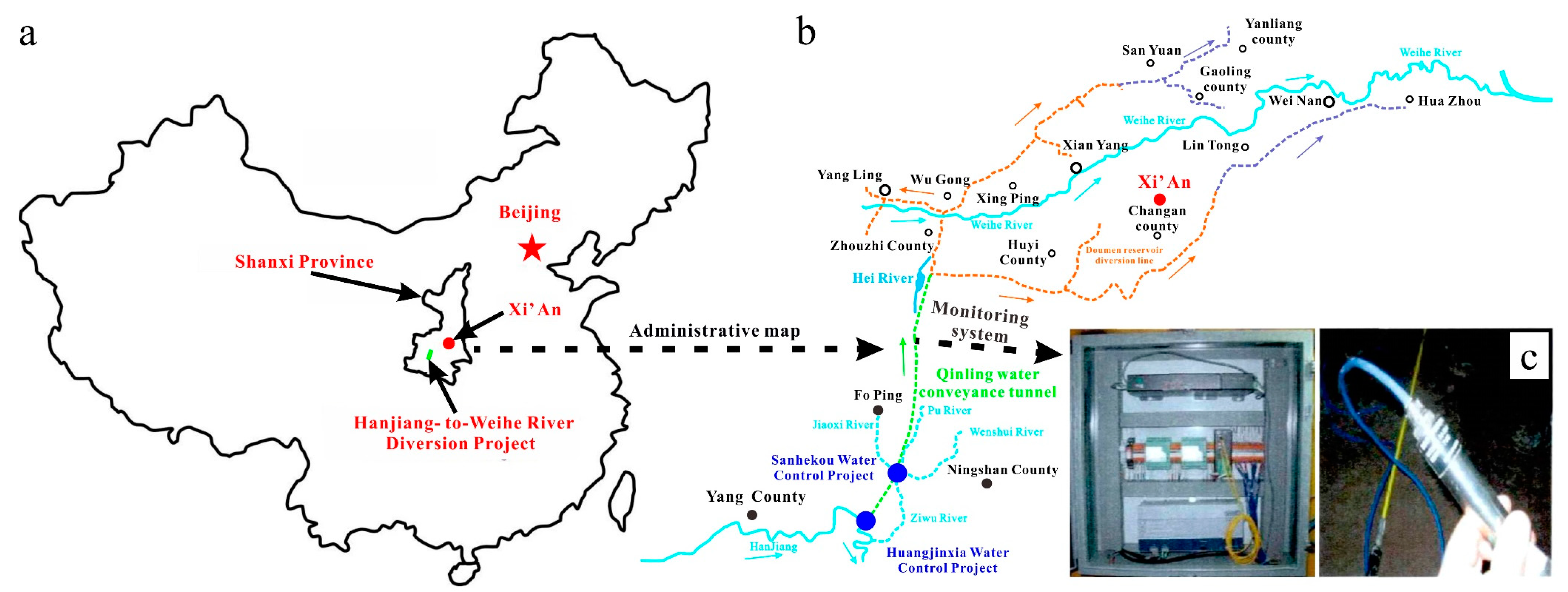

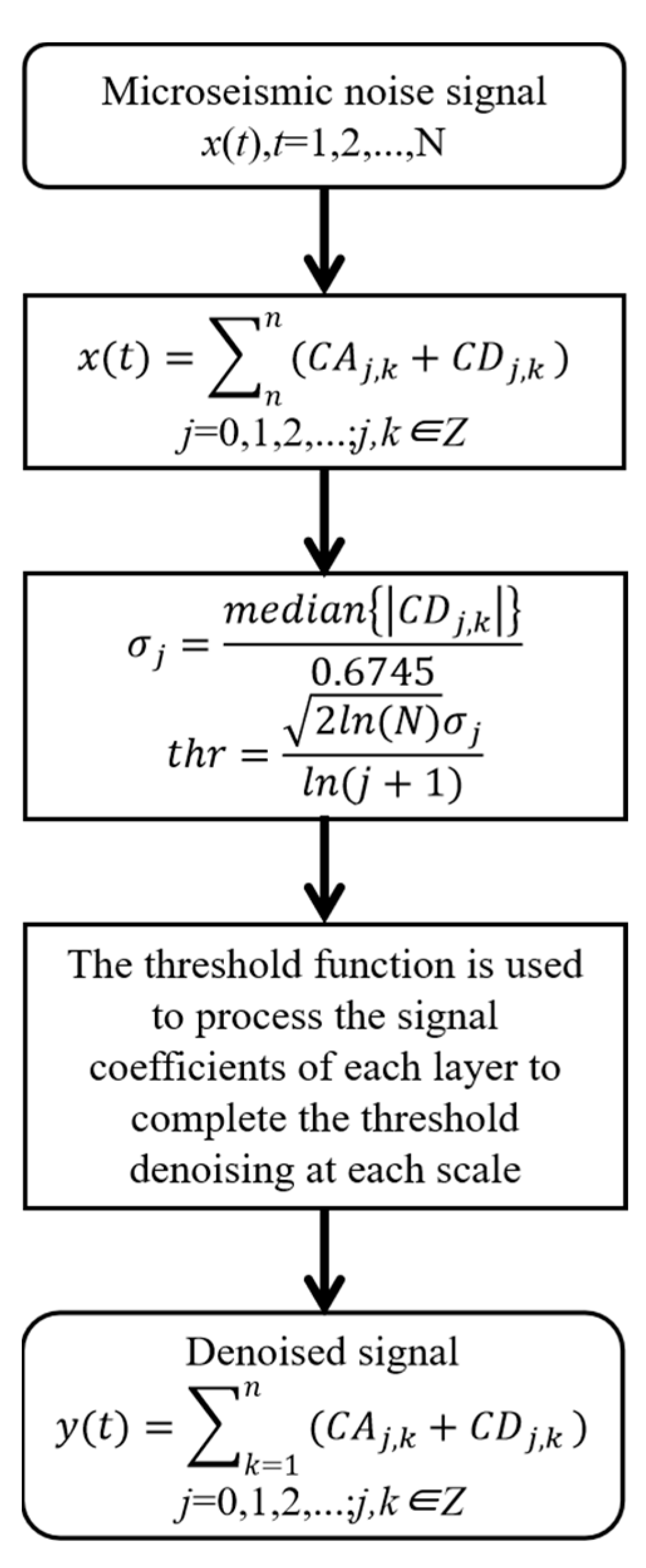

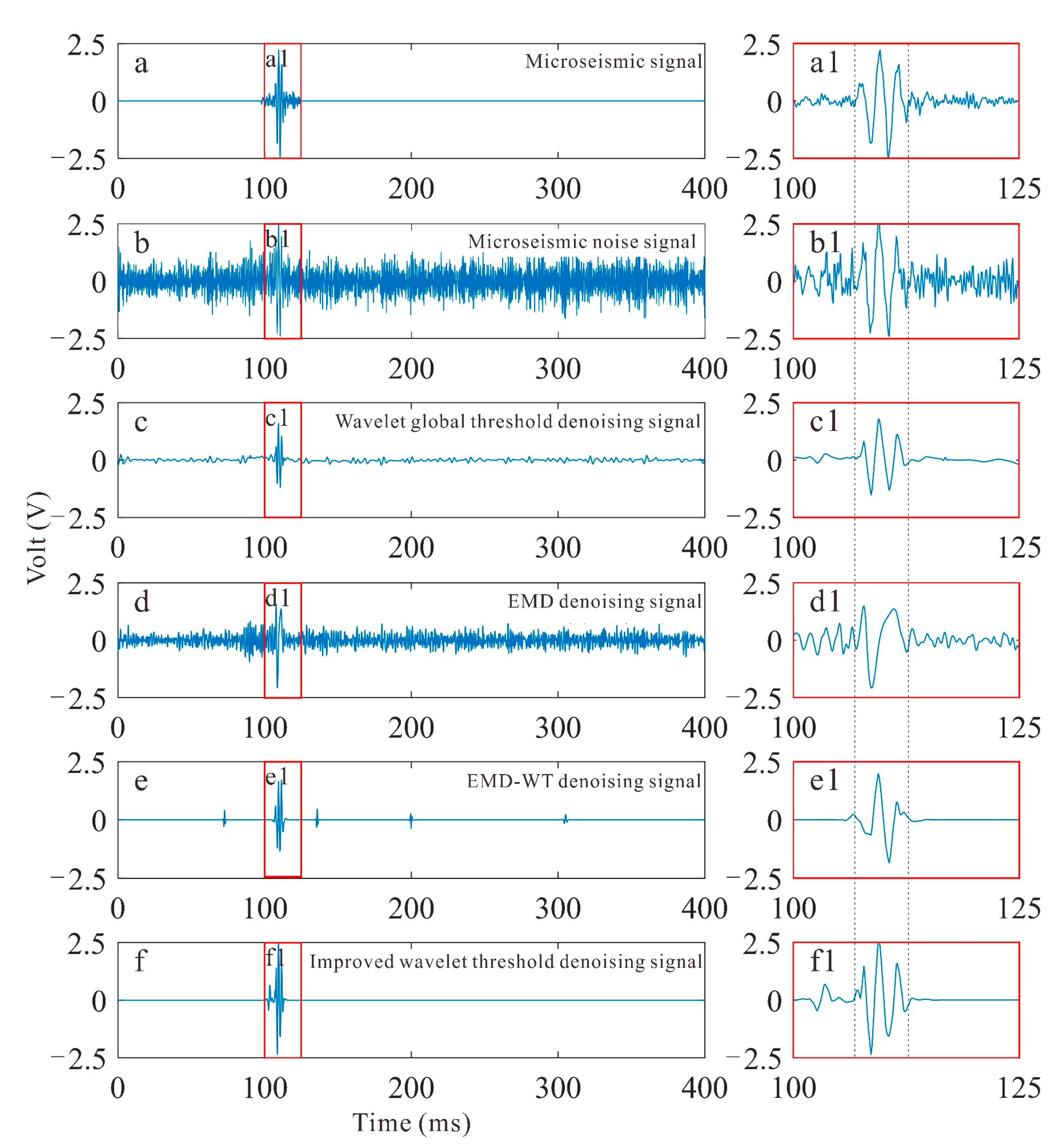

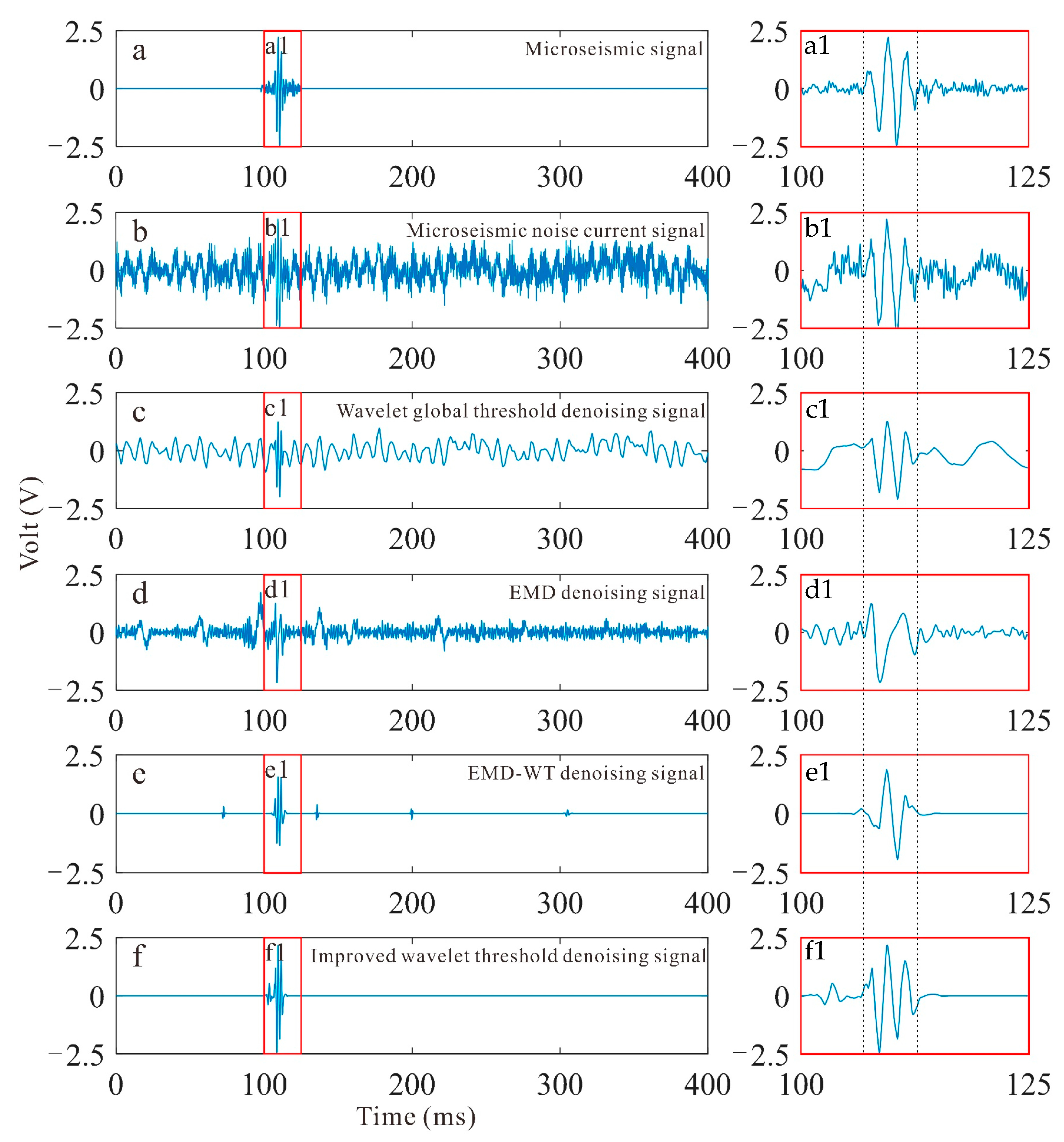
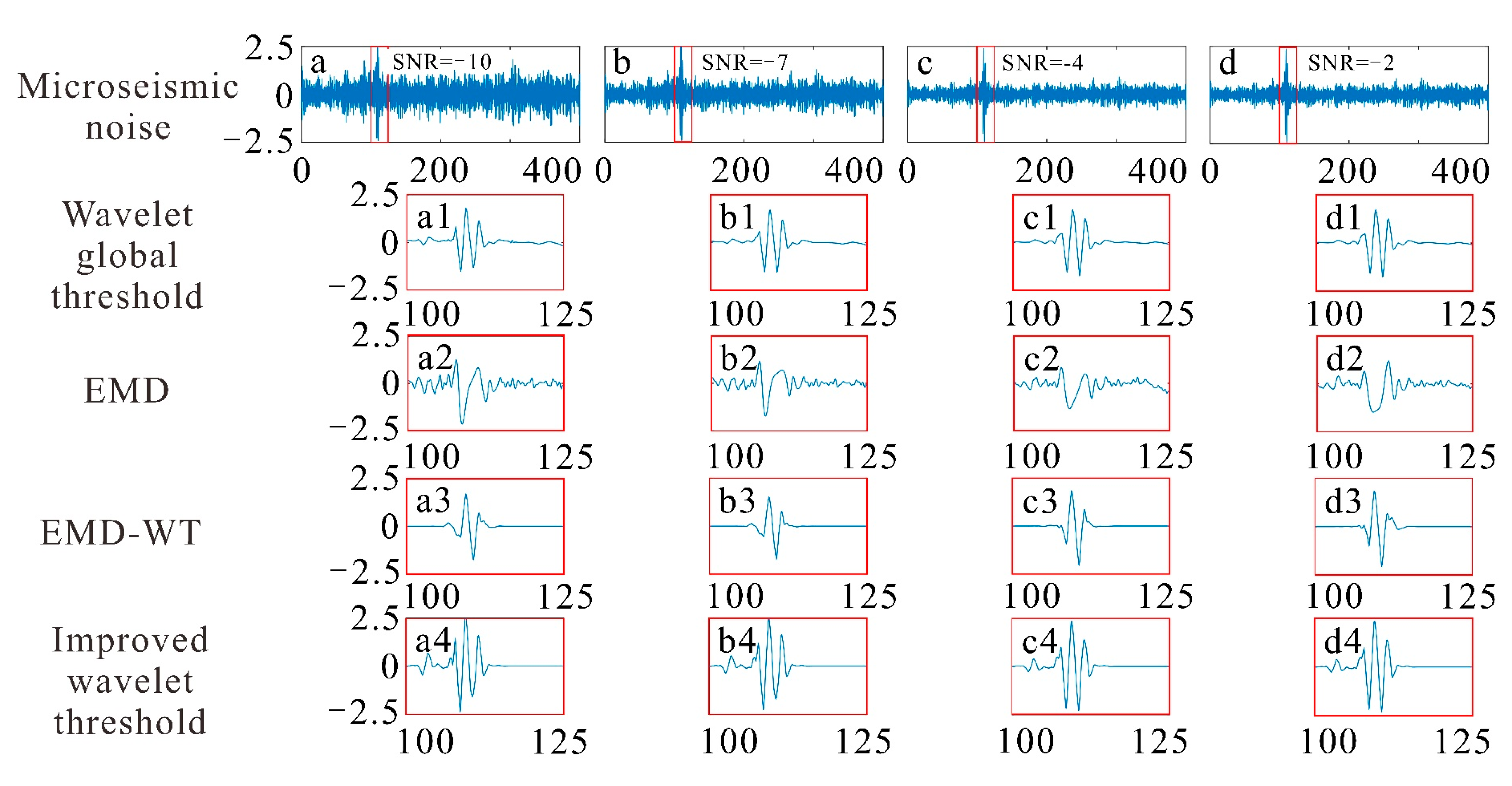

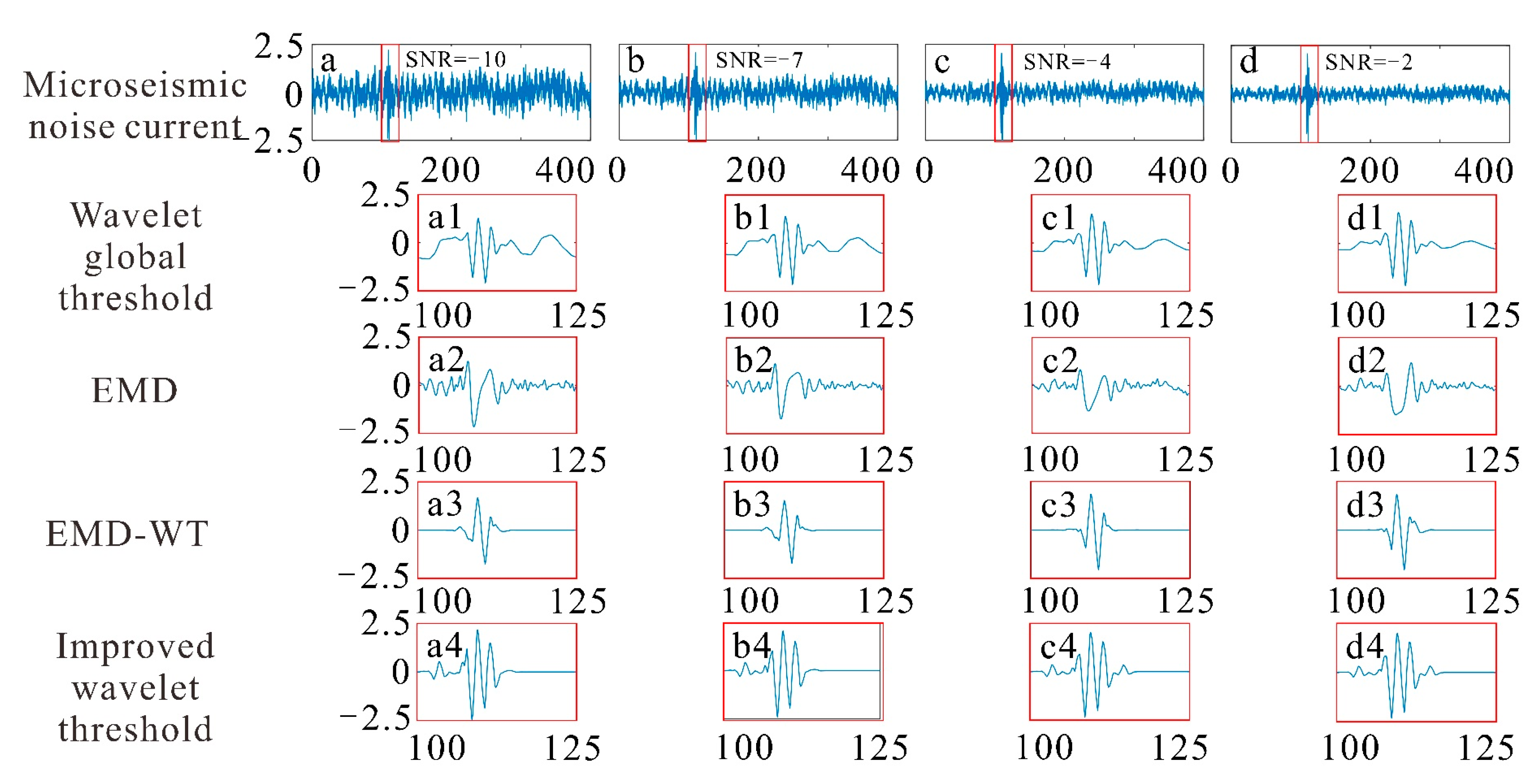
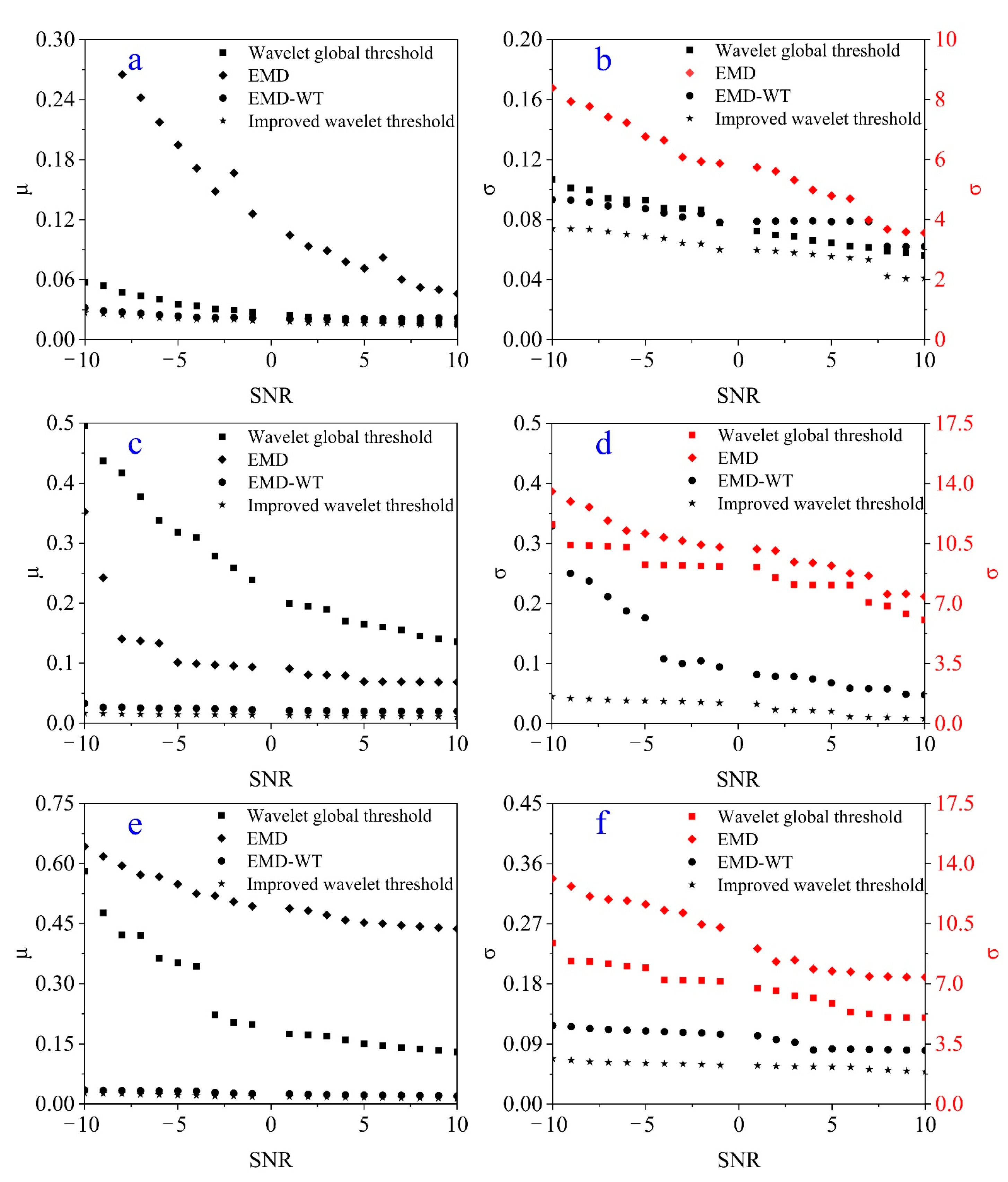
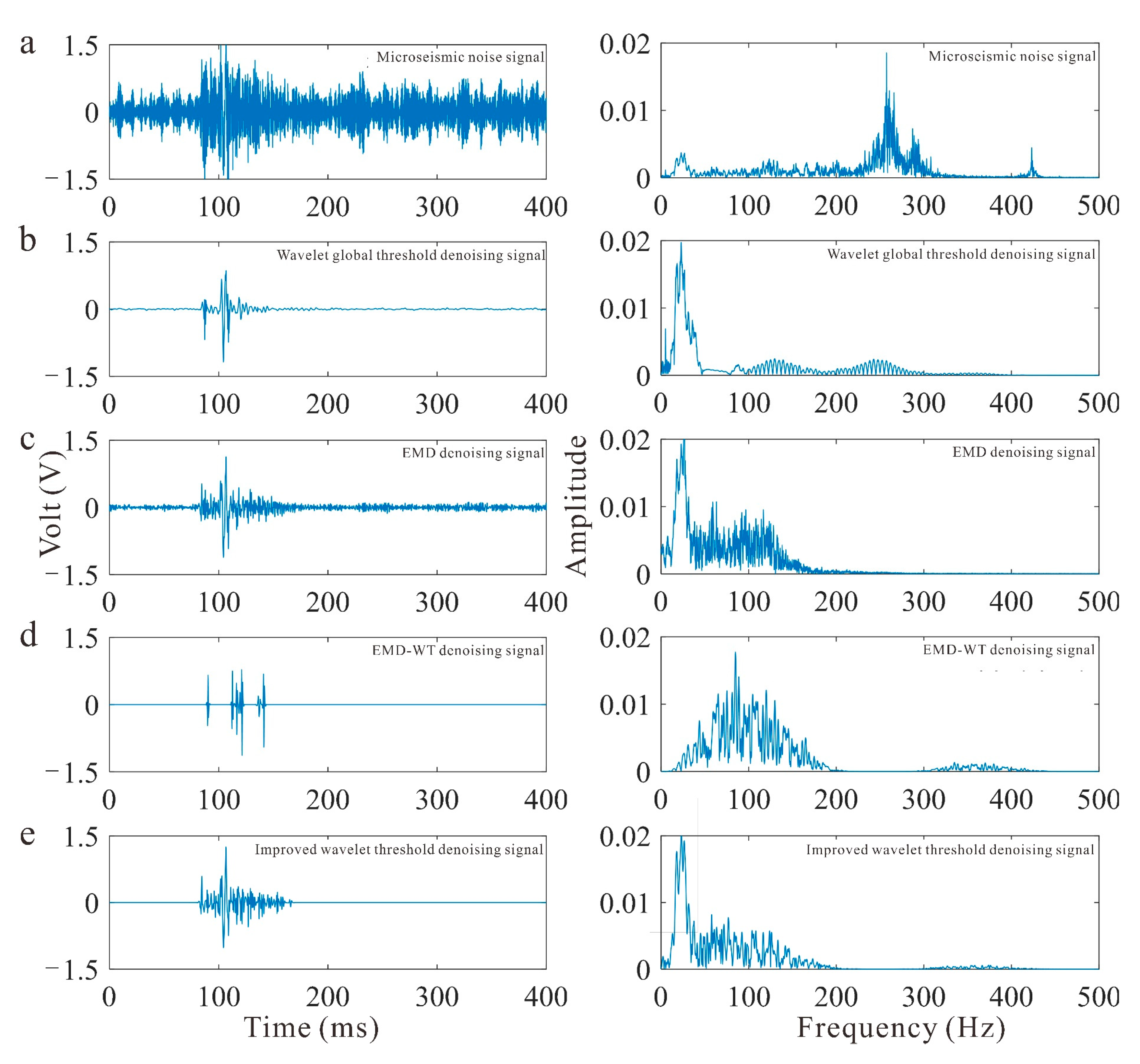
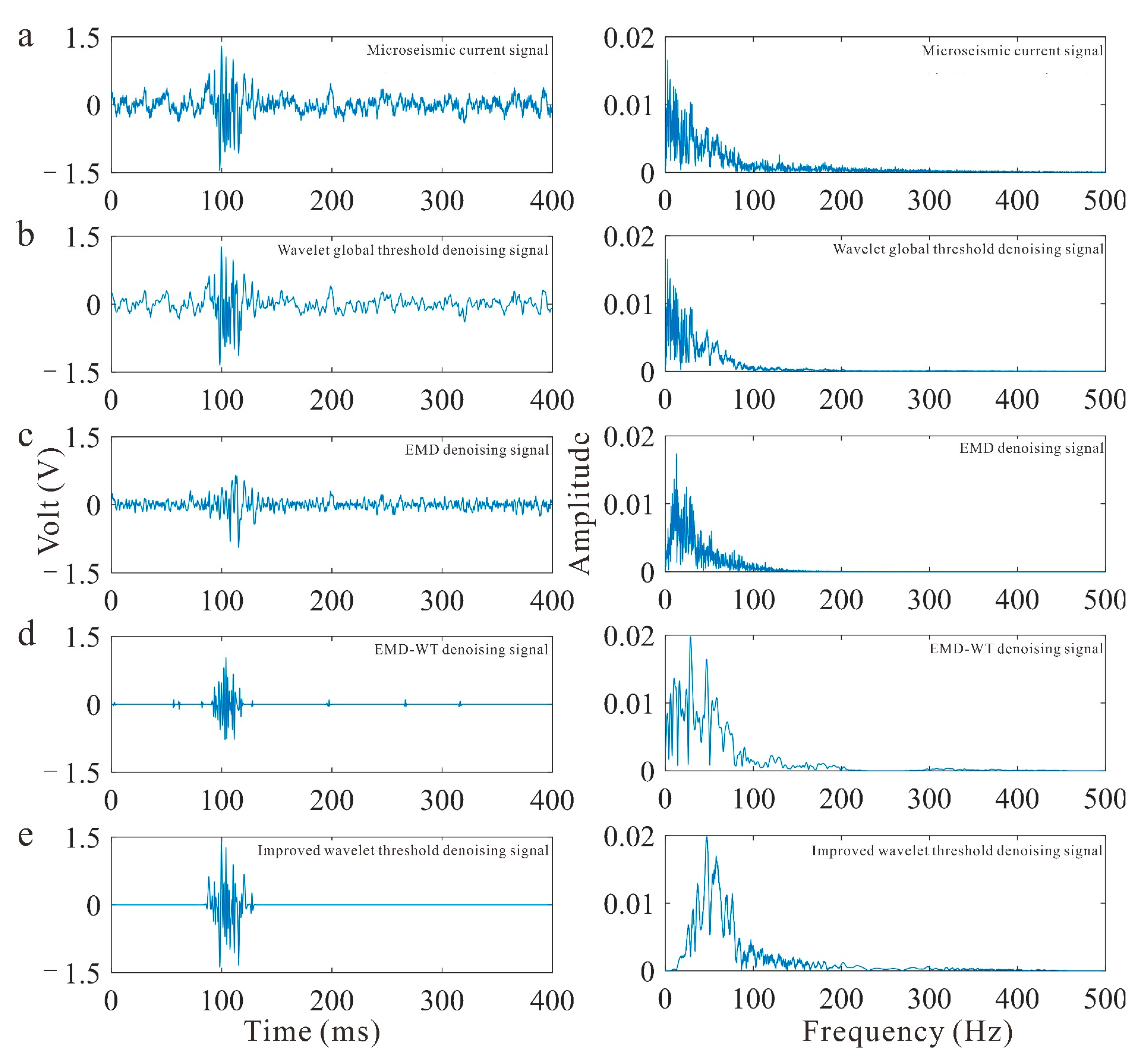

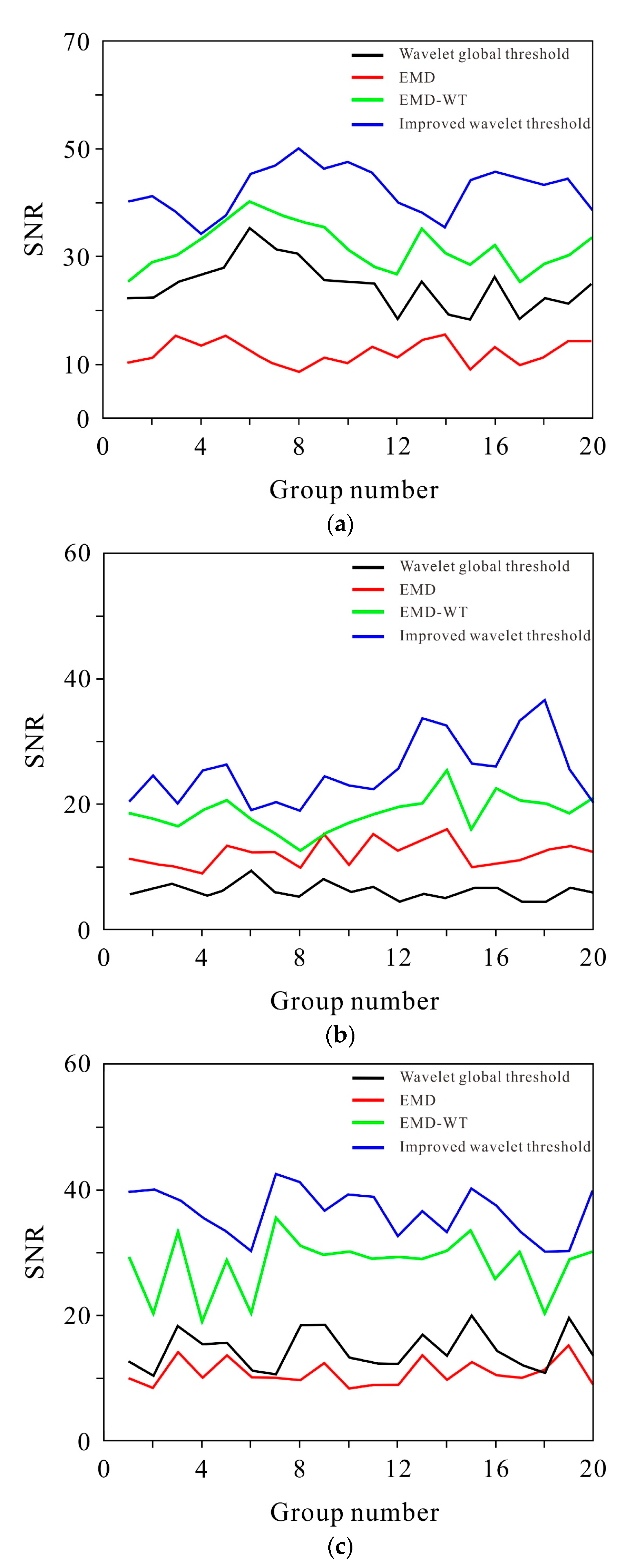
| Decomposition Layers | μ | σ |
|---|---|---|
| 4 | 0.0237 | 0.0736 |
| 5 | 0.0346 | 0.0798 |
| 6 | 0.0482 | 0.0826 |
| 7 | 0.0688 | 0.0826 |
| SNR | Hard Threshold | Soft Threshold | Improved Threshold | |||
|---|---|---|---|---|---|---|
| μ | σ | μ | σ | μ | σ | |
| 5 | 0.0109 | 0.0879 | 0.0050 | 0.0544 | 0.0041 | 0.0348 |
| −2 | 0.0127 | 0.0946 | 0.0071 | 0.0602 | 0.0059 | 0.0566 |
| −10 | 0.0137 | 0.0994 | 0.0107 | 0.0745 | 0.0083 | 0.0622 |
| Synthesis Signal Types | Wavelet Global Threshold | EMD | EMD-WT g | Improved Wavelet Threshold | ||||
|---|---|---|---|---|---|---|---|---|
| μ | σ | μ | σ | μ | σ | μ | σ | |
| Microseismic noise | 0.4838 | 0.6842 | 0.2420 | 6.8444 | 0.0235 | 0.0892 | 0.0217 | 0.0736 |
| Microseismic current | 0.4953 | 0.6085 | 0.2522 | 6.3877 | 0.0237 | 0.1031 | 0.0166 | 0.0447 |
| Microseismic noise current | 0.4958 | 0.6534 | 0.2426 | 6.4657 | 0.0246 | 0.0890 | 0.0229 | 0.0791 |
| Denoising Method | Evaluation Indicator | Noise Signal | ||
|---|---|---|---|---|
| Microseismic Noise | Microseismic Current | Microseismic Noise Current | ||
| Wavelet global threshold | SNR | 25.3288 | 5.9592 | 13.3623 |
| MSE | 0.0113 | 0.0180 | 0.0997 | |
| r | 0.5222 | 0.5789 | 0.4791 | |
| EMD | SNR | 10.1585 | 10.1868 | 8.2862 |
| MSE | 0.0313 | 0.0942 | 0.0850 | |
| r | 0.4036 | 0.7139 | 0.6695 | |
| EMD-WT | SNR | 31.4134 | 16.9703 | 30.1518 |
| MSE | 0.0019 | 0.0206 | 0.1634 | |
| r | 0.2681 | 0.3872 | 0.1210 | |
| Improved wavelet threshold | SNR | 47.9287 | 22.9659 | 39.3210 |
| MSE | 0.0011 | 0.0062 | 0.0547 | |
| r | 0.6923 | 0.9163 | 0.7924 | |
Disclaimer/Publisher’s Note: The statements, opinions and data contained in all publications are solely those of the individual author(s) and contributor(s) and not of MDPI and/or the editor(s). MDPI and/or the editor(s) disclaim responsibility for any injury to people or property resulting from any ideas, methods, instructions or products referred to in the content. |
© 2023 by the authors. Licensee MDPI, Basel, Switzerland. This article is an open access article distributed under the terms and conditions of the Creative Commons Attribution (CC BY) license (https://creativecommons.org/licenses/by/4.0/).
Share and Cite
Tang, S.; Ding, S.; Li, J.; Zhu, C.; Cao, L. An Improved Microseismic Signal Denoising Method of Rock Failure for Deeply Buried Energy Exploration. Energies 2023, 16, 2274. https://doi.org/10.3390/en16052274
Tang S, Ding S, Li J, Zhu C, Cao L. An Improved Microseismic Signal Denoising Method of Rock Failure for Deeply Buried Energy Exploration. Energies. 2023; 16(5):2274. https://doi.org/10.3390/en16052274
Chicago/Turabian StyleTang, Shibin, Shun Ding, Jiaming Li, Chun Zhu, and Leyu Cao. 2023. "An Improved Microseismic Signal Denoising Method of Rock Failure for Deeply Buried Energy Exploration" Energies 16, no. 5: 2274. https://doi.org/10.3390/en16052274





